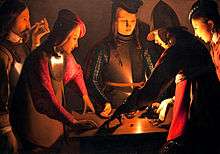Preston Hall, Preston-on-Tees

| Preston Hall | |
|---|---|
 Preston Hall | |
| OS grid reference | NZ430158 |
| Coordinates | 54°32′10″N 1°20′13″W / 54.536°N 1.337°W |
| |
Preston Hall is an early 19th-century mansion house at Preston on Tees, Stockton-on-Tees, England. It has been a museum since 1953 and is owned by Stockton-on-Tees Borough Council. It is a listed building.[1][2] The house stands in 100 acres (0.40 km2) of parkland. The grounds of the house form Preston Park.
The manor of Preston on Tees was held in 1515 by William Sayer but was lost when the estates of Lawrence Sayer, who was a Royalist during the English Civil War, were sequestered and sold by the Commonwealth of England.[3] In 1673 the manor was purchased by George Witham and during the residency of the Witham family the manor house was known as Witham Hall.[3] In 1722 William Witham sold the estate to Sir John Eden Bt of Windlestone Hall and in 1820 it was sold again to David Burton Fowler.
In 1825 Fowler built the present Preston Hall as a modest two-storey three-bayed rectangular structure with a service wing.[2] The old manor house was retained in use as a farmhouse until its demolition in 1974.
In 1882 Marshall Fowler sold the estate to Robert Ropner,[3] a shipping merchant and shipbuilder, who was High Sheriff of Durham in 1896 and who became a baronet in 1904. He extended the property by the addition of substantial wing blocks, and in about 1900 he added a large and recently renovated winter garden or conservatory.[2] The Ropner baronets lived in the house until 1937 (in which year Leonard Ropner served as High Sheriff). It was acquired by the Stockton on Tees District Council in 1947.
The Dice Players

The museum contains a valuable painting called The Dice Players by Georges de La Tour. The painting has occasionally been lent out for exhibition elsewhere and is regarded as a very fine example of the artist's work.[4]
The painting was part of a collection left to the borough in 1930 by a Leicester lady in memory of her father, Edwin Clephan, who had been born in Stockton, but the significance of this item was not realised until 1972.
Restoration grant
In April 2008, the Heritage Lottery Fund awarded a grant of £3.7 million towards a major refurbishment of the building and the museum's collections.[5]
References
External links
- Preston Park Museum & Grounds - official site